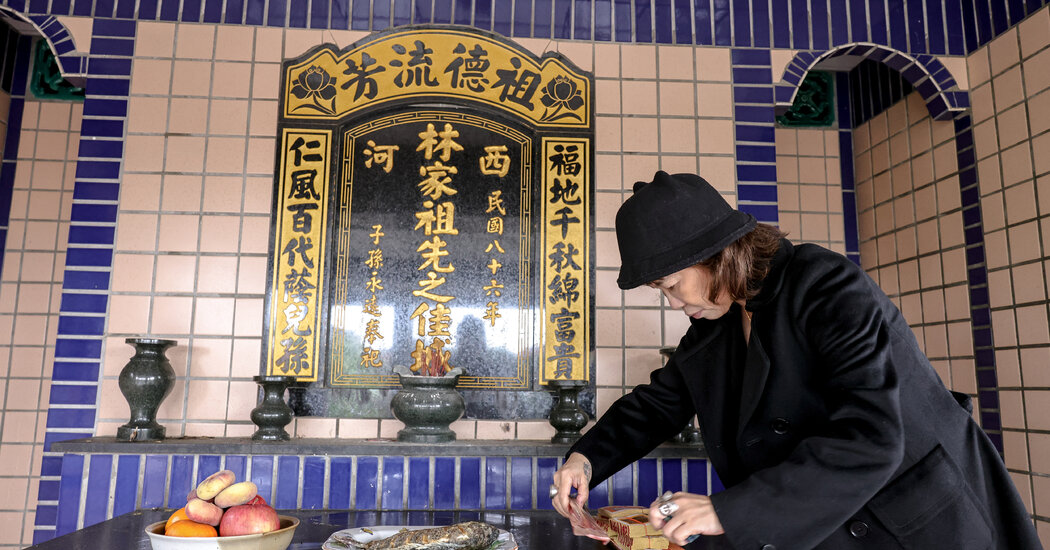
TAIPEI, Taiwan — While growing up in Hong Kong, Cherry Tang accompanied her uncles to their family’s ancestral gravesite each spring as they lugged a whole roasted suckling pig up a subtropical hillside.
The pig was placed in front of the tomb, alongside fruit and incense, and Ms. Tang helped relatives weed and clean as they waited for their ancestors’ spirits to dine on the offerings. Then, the family feasted. Her uncles chopped the pig into bite-size pieces to dip in hoisin sauce, and other relatives passed around small cartons of lemon tea.
For the annual spring holiday of Qingming, known as Tomb Sweeping Day in English, extended families gather to honor the departed, clean ancestors’ graves and feed their spirits in a Chinese folk practice that dates back 2,500 years. Celebrated on April 5 this year, it is observed by the Chinese and the Chinese diaspora throughout the world.
But the act of sweeping tombs is becoming obsolete as the tombs themselves are being phased out. In recent decades, governments across East and Southeast Asia have pushed for cremation to replace tomb burials. Others have razed cemeteries. The shift is especially prevalent on densely populated islands and in seaside cities, where burial land is scarce and therefore tomb burials are prohibitively expensive. Most families now house ashes inside columbariums, structures that can store thousands of cremation urns in the same amount of space that a few tombs would have taken.
Even though there is little to sweep in a columbarium (most have staff who clean regularly), families still gather on Qingming to feed their ancestors. After the spirits are satiated, the living eat and enjoy the offerings. Food is a vital part of the holiday, but the home-cooked feasts that were typically offered to the deceased have been replaced over the years by smaller meals and store-bought snacks.
Traditionally, whole animals were presented as offerings alongside regional dishes special to the holiday, such as spring rolls or mugwort-flavored rice dumplings. “Early Han Chinese societies would use livestock to honor the heavens, the earth god and their ancestors,” said Wen Tsung-Han, a folklore scholar and author in Taiwan.
Gemma Lin, 51, a chef and the owner of Bad Mama Keelung, in Taiwan, said that her mother woke up early to prepare fish, chicken and pork belly for the occasion. These dishes are served for the holiday both because they represent the best of the ocean, air and land, but also because they reheat well. Her mother transformed the offerings, cold from sitting out at the tomb, into a hot family meal. She braised the pork belly and broke down the poultry to make three-cup chicken.
Her mother also liked to pan-fry a whole sea bass and blanket it with a sour, savory sauce. Ms. Lin now cooks a spin on that family classic, topping the fish with fresh vegetables and a tangy tomato dressing.
Ms. Tang, 41, who remembers her family’s tombside festivities with a whole suckling pig in Hong Kong, has experienced the shifts in tradition in recent years. When her maternal grandmother passed away in 2018, the family opted to house her ashes inside a columbarium at Ching Chung Koon, an elaborate Taoist temple in Hong Kong.
“We’ll bring flowers and fruit, and sometimes a slab of crispy pork belly,” Ms. Tang said.
Ms. Tang’s family offering of pork belly, siu yuk in Cantonese, has two contrasting textures: skin so crunchy that it pops and a tender slab of meat underneath. Ms. Tang made siu yuk for supper clubs when she lived in London, but back in Hong Kong, she just buys a slab, like everyone else.
At the columbarium, there simply is not enough space for a whole pig. And most people don’t bother to prepare dishes from scratch. It’s now increasingly common to see packaged food and even snacks and fast food on these altars.
“In urban areas, many young people don’t have experience with tomb burials,” said Wu Bo-Wei, 30, a Taiwanese heritage activist who works on tomb preservation. “They’re unfamiliar with the traditions and will just go the columbarium and make a simple offering.”
Nancy Fam, 93, who is Malaysian Chinese, was in charge of the offerings for her husband’s ancestors when she lived in Kuala Lumpur, Malaysia, from the 1950s to the early ’80s. She arranged elaborate altar spreads with cuttlefish, a whole chicken delicately poached with aromatics, two duck eggs, one spring onion, three cups of tea, three cups of wine and five bowls of rice, among many other dishes.
After the spirits had dined, which she gauged with a double coin toss — two heads meant they were satisfied — she removed the food from the altar and prepared it for the living to enjoy. Using a recipe from her mother, Ms. Fam carved the chicken to serve to her family as chicken rice with a dipping sauce of shallots, lime and ground bean sauce.
Ms. Fam moved to Southern California in 1982; her youngest son, Bobby Yeo, who still resides in Kuala Lumpur, took on the responsibility of feeding their dead. Mr. Yeo, 69, does his best to follow his mother’s example, albeit on a much smaller scale.
This year, he plans to visit his father’s grave and bring him some of his favorite foods: roast and braised pork, pig’s ears and a couple cans of beer.
“We have to do our duty,” Mr. Yeo said.
For Ms. Fam and some of the older generation, it’s important to make an effort because the erosion of culinary traditions comes at the expense of the deceased. “McDonald’s is not going to cut it,” she said. “The spirits will be tortured.”



